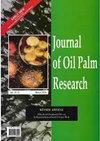棕榈基c12脂肪酸与二甘醇自酯化的常规和微波加热动力学研究
IF 1.3
4区 农林科学
Q2 Agricultural and Biological Sciences
引用次数: 0
摘要
二月桂酸二甘醇(DEG-DL)来源于棕榈油,可以使用酯化或酯交换技术生产。此外,催化反应或非催化反应都有助于该过程,无论是否使用溶剂。然而,目前DEG-DL的生产仍然使用传统的方法,需要更长的时间才能生产出高质量的酯。在这项工作中,DEG-DL的生产是在没有催化剂的情况下使用无溶剂微波加热方法进行的。与传统加热相比,无溶剂微波加热方法是一种生产DEG-DL的有效方法,反应时间从22小时缩短到2小时。使用FTIR和1H-NMR对产生的DEG-DL及其酸值进行了表征,以观察其趋势。研究了两种加热方法对酯的动力学和热力学参数的影响,并进行了比较。根据所得结果,与传统加热方法和微波加热方法相比,动力学反应符合拟一级反应,活化能降低了24%,指数前因子增加了93%。生产的DEG-DL是一种潜在的成分,可用于乳胶漆配方中的聚结助剂。本文章由计算机程序翻译,如有差异,请以英文原文为准。
KINETIC STUDY OF SELF-ESTERIFIED PALMBASED C12 FATTY ACID AND DIETHYLENE GLYCOL USING CONVENTIONAL AND MICROWAVE HEATING
Diethylene glycol dilaurate (DEG-DL), which is derived from palm oil, may be produced using either esterification or a transesterification technique. Moreover, either a catalytic or non-catalytic reaction can help the process, along with or without the use of a solvent. However, currently the production of DEG-DL is still using the conventional method with a longer time to produce a good quality ester. In this work, the DEG-DL production was done using a solvent-free microwave heating method in the absence of a catalyst. The solvent-free microwave heating method exhibited itself as an effective method to produce DEG-DL with a shorter reaction time from 22 hr to 2 hr compared to conventional heating. The DEG-DL produced has been characterised using FTIR and 1H-NMR as well as its acid value to observe the trend. The effects of kinetic and thermodynamic parameters of the ester were investigated and compared between both heating methods. Based on the result obtained, the kinetic reaction fitted the pseudo-first-order well with 24% decreased in the activation energy and the pre-exponential factor increased by 93% when comparing conventional and microwave heating methods. The DEG-DL produced is a potential ingredient to be used as coalescent aid in latex paint formulations.
求助全文
通过发布文献求助,成功后即可免费获取论文全文。
去求助
来源期刊

Journal of Oil Palm Research
农林科学-食品科技
CiteScore
2.60
自引率
30.80%
发文量
69
审稿时长
>12 weeks
期刊介绍:
JOURNAL OF OIL PALM RESEARCH, an international refereed journal, carries full-length original research papers and scientific review papers on various aspects of oil palm and palm oil and other palms. It also publishes short communications, letters to editor and reviews of relevant books. JOURNAL OF OIL PALM RESEARCH is published four times per year, i.e. March, June, September and December.
 求助内容:
求助内容: 应助结果提醒方式:
应助结果提醒方式:


